
Nuage Vert, Saint Ouen, 2003, photo HeHe
Pollstream is a collection of ideas, forms and images that explore man-made clouds. We are fascinated by clouds because of their movement, and because of their natural undefined form - which makes them difficult to be fixed in time.
Across a number of projects, clouds are used as a visual metaphor to aestheticise emissions and chemical toxins.
In popular culture, the meaning of man-made clouds, have changed to reflect the concerns of the ages: They have been used in the 19th century as a sign of economic prosperity, in the 1920's to express spiritual energy, in the 60's as am emblem for workers revolution, in the 80's as the ultimate icon of pollution. Likewise, pollstream offers alternative meanings for today's man-made clouds, which, hopefully, challenge the ideologies of our times.
This project is an intervention in environmental ethics. It creates a series of environments and processes to monitor and localise pollution at the very same time that it is produced; to conceptualise oneself as responsible – collectively and individually – for our emissions. As consumers our default position is one of disengagement – we rely on others to clear up our mess, to hide it in landfill, for example, or toxics inside our body. And the abstraction of inescapably globalised pollution, escalating beyond the control of any individual nation state, can easily undermine a sense that localised actions are worthwhile or effective.
Pollstream, using visual, kinetic and sonic technologies, undermines these typical defences of disengagement by speeding up the normal time it takes for our actions in and on the environment to have consequences. Across a number of projects, a sense of constant rather than delayed feedback is created. Thus, in its final form, color coded communal information is projected onto the vapor of a power plant that is visible to all residents. The movement of the green vapor emission changes size to show levels of energy being consumed at any given time; the chimney becomes a community measuring tape, a shared canvas. Nuage Vert is the ultimate aesthetisation of pollution, while seeking to draw critical attention to it. It becomes a sign of wonder, a spectacle; a space is opened up for the spectator. Could they become mesmorised by a beauty that is, literally and metaphorically, a smokescreen? Will they
retreat to making this (terrible) beauty another defence?
------------------------------------------------------------------------------------------------------------------------------------
Index to the Pollstream series:
PROPOSAL nº 8 : Million parts INSTALLATION / France Fiction, Paris
PROPOSAL nº 7 : Toy emissions PERFORMANCE / Eyebeam, NYC
PROPOSAL nº 6 : Air de Londres PHOTOGRAPHY / The 2nd International Artists Air Show, Arts Catalyst, London
PROPOSAL nº 5 : Champs d'Ozone INSTALLATION / Air de Paris, Centre Georges Pompidou, Paris
PROPOSAL nº 4 : Smoker's Lamp & CO2 room OBJECT / Galerie Vanessa Quang, Paris
PROPOSAL nº 3 : Nuage Vert INSTALLATION - LARGE SCALE / Pixelache 2008, Helsinki
PROPOSAL nº 2 : Emission-transmission UNCOMPLETED
PROPOSAL nº 1 : Pollstream v1 UNCOMPLETED
------------------------------------------------------------------------------------------------------------------------------------
PROPOSAL nº 8 : Million parts
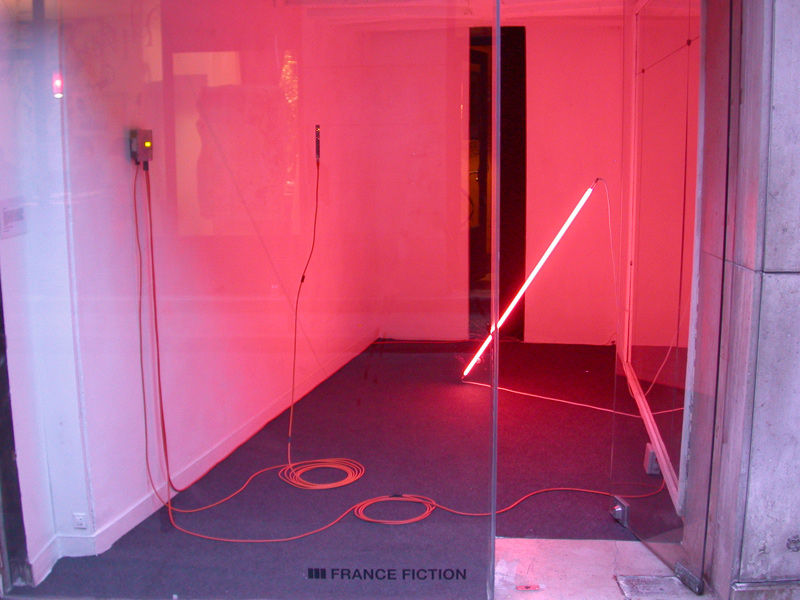
PROPOSAL nº 7 : Toy emissions
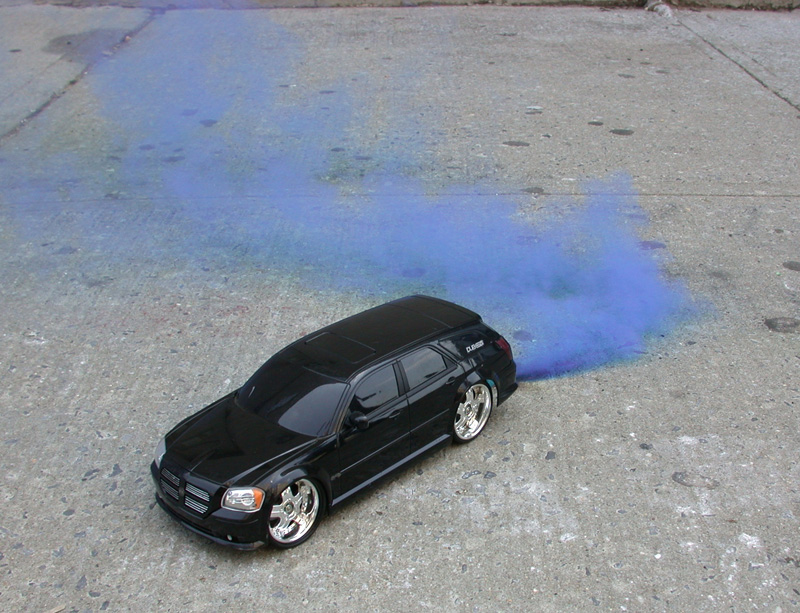
PROPOSAL nº 6 : Air de Londres
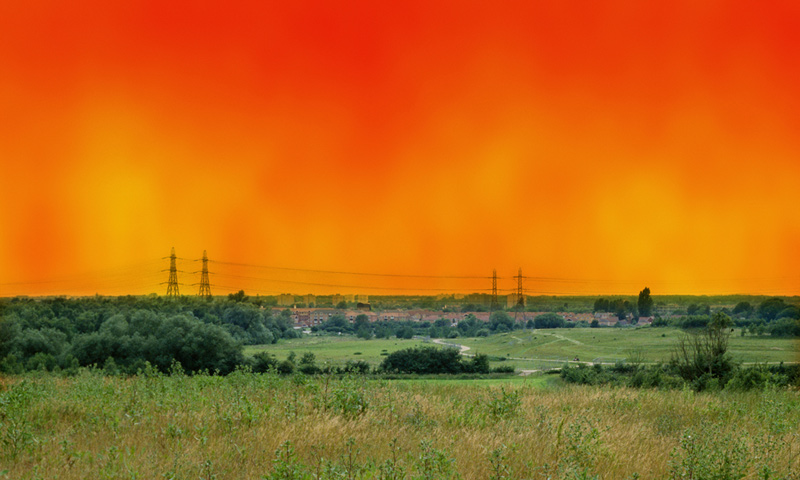
PROPOSAL nº 5 : Champs d'Ozone
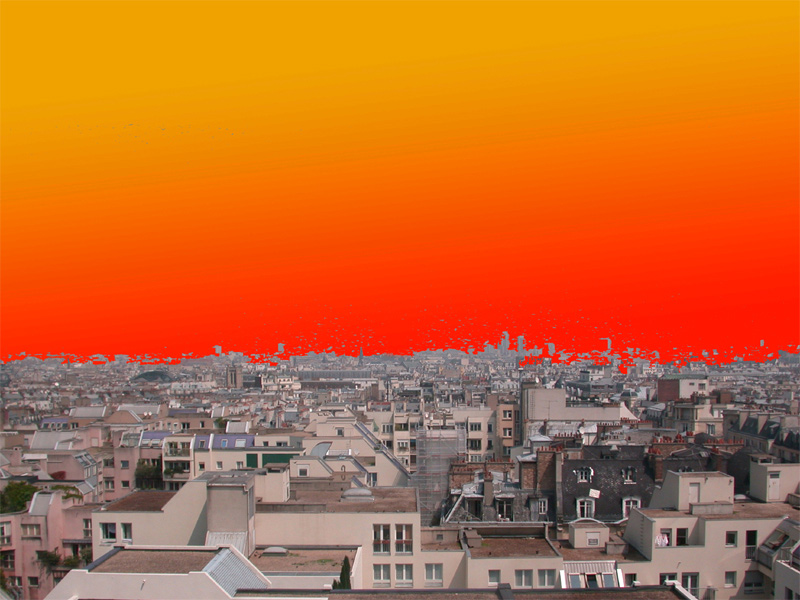
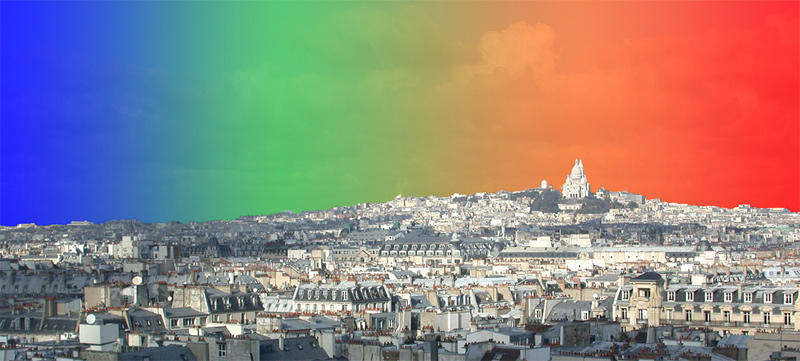
PROPOSAL nº 4 : Smoker's Lamp & CO2 room

For scientists and chemists, air borne pollution is generally measured in Parts Per Million (ppm). Health and safety experts translate these numeric measurements across a range that usually spans from “normal saturation in office buildings” to “instantly lethal”. The proposed objects decipher categorical numbers and terms, such as “end-tidal breath” into collective experiences.
Developed during a residency at Nordic Institute of Contemporary Art / Pixel Ache festival, the new installation that looks at interior air pollution in shared spaces. Whilst cigarette smoking remains a highly social activity, it is decreasingly tolerated throughout Europe and the US and is the second largest cause of death worldwide.
Smoker's lamp responds to cigarette smoke, changing
colour and emitting a low oscillation. The lamp has an ambiguous
status: As an object placed in a no-smoking zone in the context of
cultural events, it at once invites people to smoke to activate the
lamp and serves as an alert that the rule has been broken. For
non-smokers, we are also experimenting with C02 sensors within
conference type environments, whereby a room full of guests over a
short time increases the levels of C02 to surprisingly high levels.
What does it mean when we pollute by simply existing?
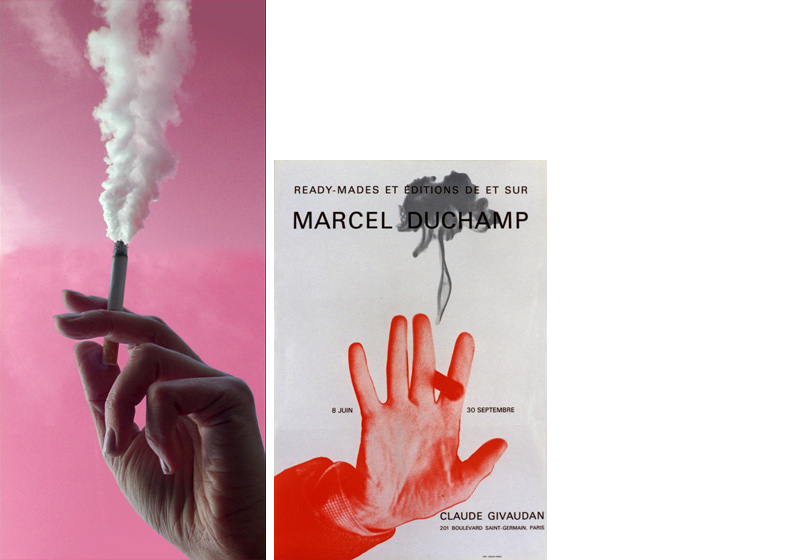 LEFT: Flyer designed by Marcel Duchamp
LEFT: Flyer designed by Marcel Duchamp
RIGHT: Flyer designed by HeHe for the exhibition INTOXICATION, Galerie
Quang, Paris, April 2006

Whenever we see a chimney emitting smoke or vapour we immediately think
of it as pollution. Chimney vapour is emblematic, symbolic of
pollution. At the same time, these emissions are intriguing and
beautiful to watch as they show the movement of the air, signalling the
direction of the wind, functioning both as weather-veins and landmarks
in the urban landscape. Supposing such smoke signals were to signal
sustainability, functioning as a kind of community measuring tape,
displaying the local effort made by citizens, when they consume less
energy (or more). The chimney becomes a more complex sign, of
environmental effort as well as wasted energy.
Originally proposed for a waste burning plant on the edge of Paris (image 3) and currently for a power plant in a residential zone of Helsinki, the project projects an informational layer onto chimney emissions. The system to realise Nuage Vert will track the movement of the plume and project back a flourescent laser outline onto its contour. The contour will change colour to show the levels of energy being currently consumed by local residents. An 'advertising' campaign will be designed to inform people of the colour spectrum being used and to tempt people to consume less energy.
By projecting changing levels of consumer demand for energy onto the plume, Nuage Vert is an experiment that makes the chimney function as a kind of community measuring tape, displaying the local effort made by citizens, publicly showing residents levels of energy consumption. The chimney becomes a more complex sign, of the environmental effort made by individuals as well as industrial pollution.
 Nuage Vert, Salmisaari power
plant, Ruoholahti, the West harbour area
of Helsinki, photo HeHe
Nuage Vert, Salmisaari power
plant, Ruoholahti, the West harbour area
of Helsinki, photo HeHe
The Region of Ile de France, being one of the most urban and densely populated areas in France, produces the most amount of domestic waste per person. The waste incineration site at St Ouen is one of three that triangulate along the edges of Paris, serving the entire region. Situated 2 Km North of Paris, the St Ouen site treats the household waste of 4 Parisian arrondissements and the entire North Eastern suburb of St Denis (department 93). Waste that arrives here comes from ordinary household waste collection bins and waste which has been rejected from the local recycling site.
The constant plume emitted from the site at St ouen is visible for miles: from Sacre Coeur, the main motorway arteries of the North and from the streets in St ouen and the neibouring suburbs. It consists mostly of water vapour at 60ºC and it emits small levels of dioxins. The aim of this project is not to critique the process of incineration but to create a spectacular event that raises the level of awareness and participation amongst consumers, who play a key role in the real and tangible story of waste production.
According to SYCTOM, (the organisation that manages waste disposal for the region) recycling quantities are increasing every year, however they remain low: in 2003 only 4.6% of houshold waste production in ile de France was recycled, whilst the overall amount of household waste is increasing.
City
scale Schema, Nuage Vert, 2005, HeHe
PROPOSAL nº 2 : emission-transmission, live radio broadcast
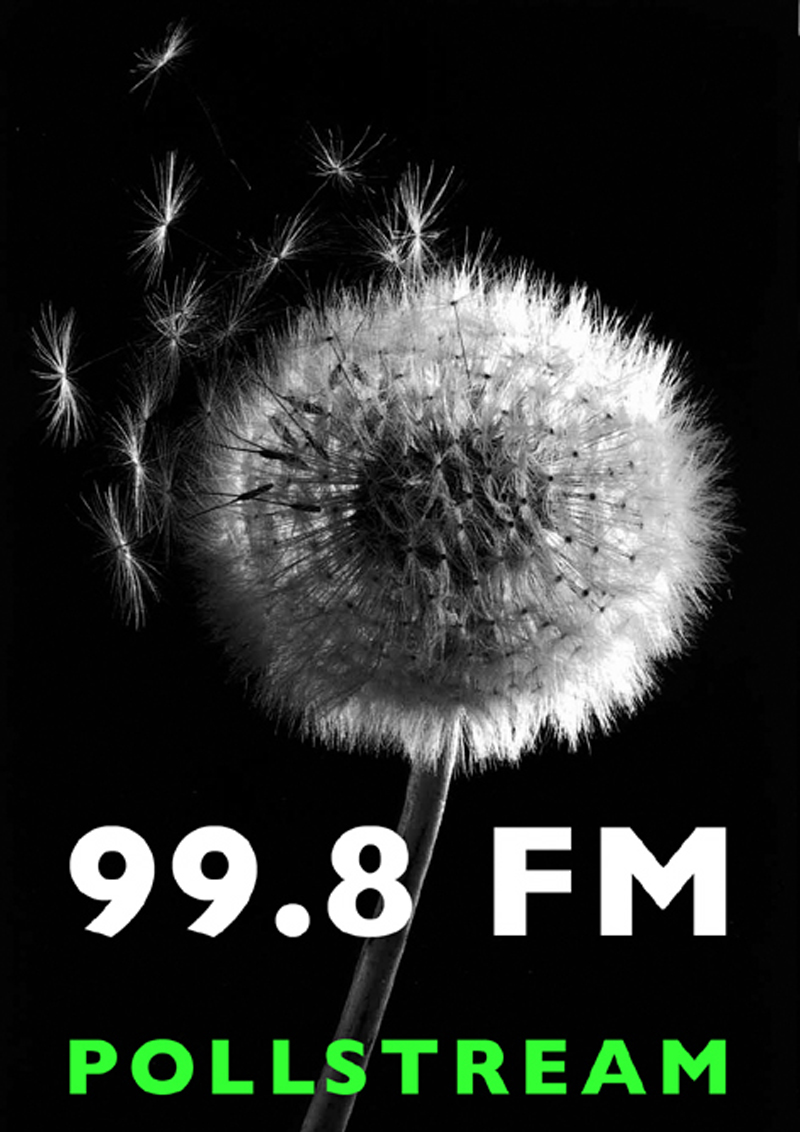
This proposal is intended as a media event for the city of Karlsruhe, to open the debate about how we define pollution and what kinds of information we have about it. It is an attempt to make people feel they have some ownership over pollution data and therefore that they have an effect on the global environment. We propose to develop a conceptual, working prototype, enabling people to have a relationship with their local pollution data.
The notion of pollution is inevitably tied to a specific system of values. Pollstream aim is to propose climate as man-made phenomena and therefore a social-political space. By visualising a man-made aspect of weather the research acts as a tactic against the popular notion that weather is “natural” [3]and beyond our control, interrogating the notion of the atmosphere is cultural, as well as physical phenomena.
The pollution data of a particular locality is sonified and transmitted the sound over FM radio band, supplying the public with an audio space that changes with their cities' pollution. An existing radio frequency is used as an input source to be mixed and re-rendered with the atmospheric data. The data is extracted from DIY CO2 sensors that react to car exhaust fumes as well as other sources focusing on the locality, such as satellites, websites and the local network of pollution monotoring sources.
PROPOSAL nº 1: untitled
 Satellite
cloud feed into sound,
realised at Makrolab,
Scotland, 2002, photo HeHe
Satellite
cloud feed into sound,
realised at Makrolab,
Scotland, 2002, photo HeHe Above us, rotating around the globe, thousands of data packages are beaming back and forth, are counted, calculated, manipulated and thrown into the ever filling data banks of global atmospheric modelling systems. Manmade materials, signals and codes permeate space, both near and far. Yet seldom do we think of this rich mix spinning around above us - since we have few means to access it.
This first prototype for PollStream is an application that displays, analyses and recodes images of cloud cover over MakroLab in Blair Atholl, the Scottish Highlands. The images were taken during the two week residency at MakroLab by the NASA satellite TERRA (EOS AM-1) with the MODIS instrument (Moderate Resolution Imaging Spectroradiometer). The software pinpoints the position of Makrolab, enlarges the image to maximum resolution and scans each pixel’s brightness. The software is able to generate and distort an audio collage according to the daily cloud patterns over Blair Atholl. Some of these audio files were recorded from radio signals picked up from Makrolab’s AR5000 wideband radio receiver. These sounds are a mixture of natural or unknown radio frequencies, air traffic control, aeronautical and meteorological codes, mobile telephone calls and utility radio transmissions. Depending upon the pattern generated by the cloud cover on a particular day, the radio samples will vary in pitch, speed, phase shift, modulation and duration. Other audio signals use an algorithm to generate sound waves according to the cloud pattern.
In Pollstream Nº 1, as in the geophysical world, the clouds interact, pollute, alter and distort audio channels as well as generate their own noises: The higher the density of the cloud, the higher the pitch and speed of the audio signal that is reflected. Heavy precipitation may cause a strong signal to reduce for a relatively short time and phase shifting. A cloud suspected of carrying an electrical charge will generate a high level of frequency interference and audio scattering.
The question is not simply, what might pollution sound like but also, how can one define pollution within the electromagnetic spectrum? Is it nature that is polluting culture or the other way around?
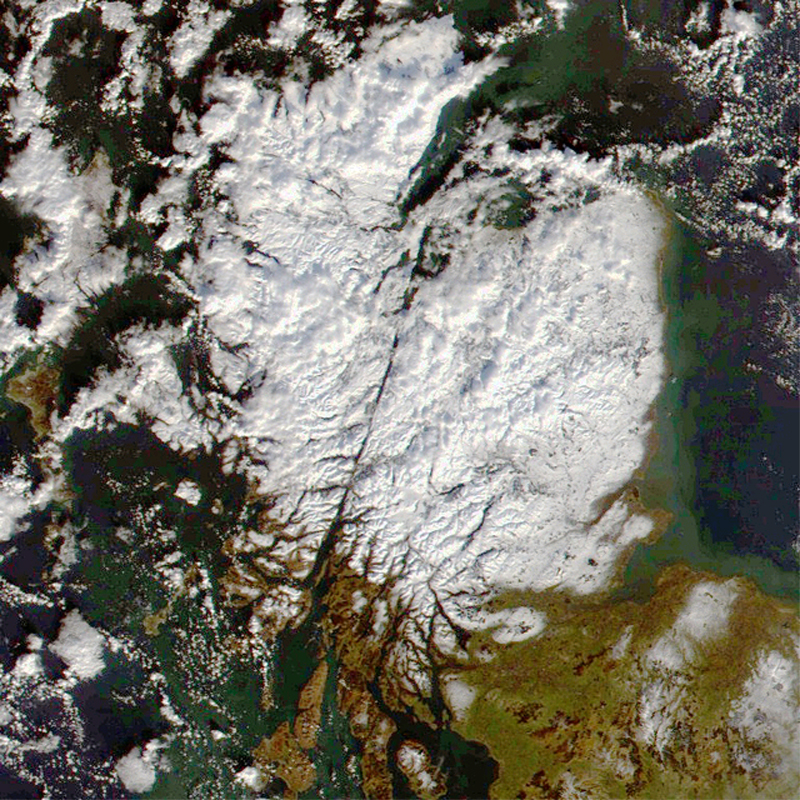 Terra
: Modis = Moderate Resolution
Imaging Spectro-Radiometer - shows Scotland under snow
Terra
: Modis = Moderate Resolution
Imaging Spectro-Radiometer - shows Scotland under snow